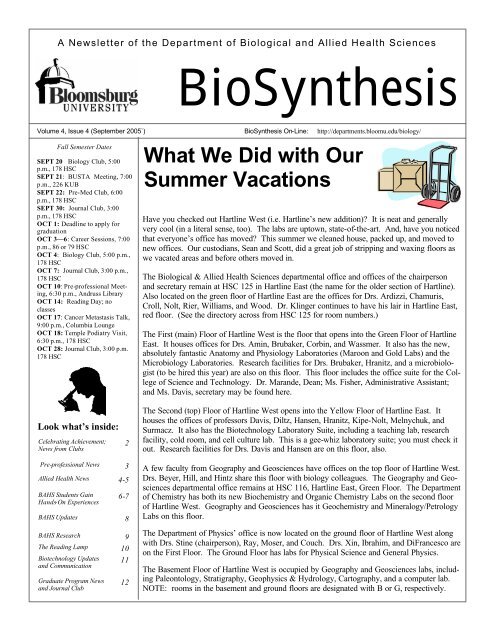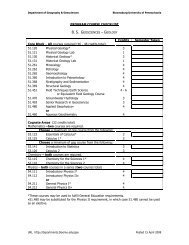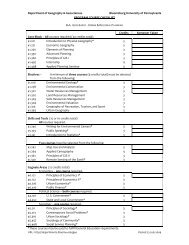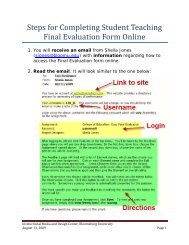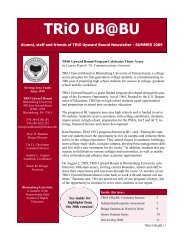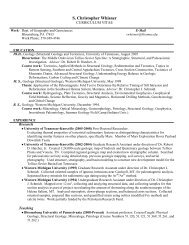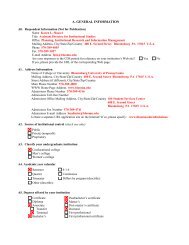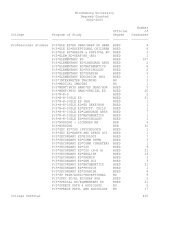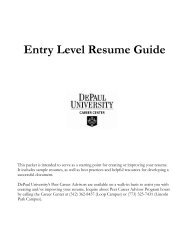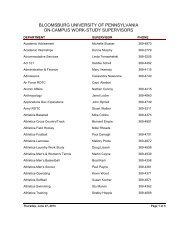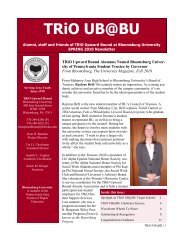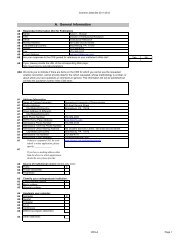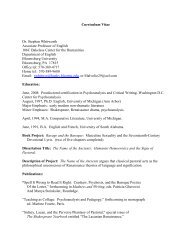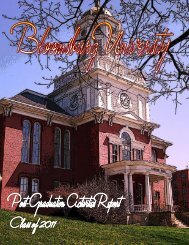BioSynthesis - Home - Bloomsburg University
BioSynthesis - Home - Bloomsburg University
BioSynthesis - Home - Bloomsburg University
Create successful ePaper yourself
Turn your PDF publications into a flip-book with our unique Google optimized e-Paper software.
A Newsletter of the Department of Biological and Allied Health Sciences<br />
Volume 4, Issue 4 (September 2005`) <strong>BioSynthesis</strong> On-Line: http://departments.bloomu.edu/biology/<br />
Fall Semester Dates<br />
SEPT 20 Biology Club, 5:00<br />
p.m., 178 HSC<br />
SEPT 21: BUSTA Meeting, 7:00<br />
p.m., 226 KUB<br />
SEPT 22: Pre-Med Club, 6:00<br />
p.m., 178 HSC<br />
SEPT 30: Journal Club, 3:00<br />
p.m., 178 HSC<br />
OCT 1: Deadline to apply for<br />
graduation<br />
OCT 3—6: Career Sessions, 7:00<br />
p.m., 86 or 79 HSC<br />
OCT 4: Biology Club, 5:00 p.m.,<br />
178 HSC<br />
OCT 7: Journal Club, 3:00 p.m.,<br />
178 HSC<br />
OCT 10: Pre-professional Meeting,<br />
6:30 p.m., Andruss Library<br />
OCT 14: Reading Day; no<br />
classes<br />
OCT 17: Cancer Metastasis Talk,<br />
9:00 p.m., Columbia Lounge<br />
OCT 18: Temple Podiatry Visit,<br />
6:30 p.m., 178 HSC<br />
OCT 28: Journal Club, 3:00 p.m.<br />
178 HSC<br />
Look what’s inside:<br />
Celebrating Achievement;<br />
News from Clubs<br />
Pre-professional News 3<br />
Allied Health News 4-5<br />
BAHS Students Gain<br />
Hands-On Experiences<br />
2<br />
6-7<br />
BAHS Updates 8<br />
BAHS Research 9<br />
The Reading Lamp 10<br />
Biotechnology Updates<br />
and Communication<br />
Graduate Program News<br />
and Journal Club<br />
11<br />
12<br />
<strong>BioSynthesis</strong><br />
What We Did with Our<br />
Summer Vacations<br />
Have you checked out Hartline West (i.e. Hartline’s new addition)? It is neat and generally<br />
very cool (in a literal sense, too). The labs are uptown, state-of-the-art. And, have you noticed<br />
that everyone’s office has moved? This summer we cleaned house, packed up, and moved to<br />
new offices. Our custodians, Sean and Scott, did a great job of stripping and waxing floors as<br />
we vacated areas and before others moved in.<br />
The Biological & Allied Health Sciences departmental office and offices of the chairperson<br />
and secretary remain at HSC 125 in Hartline East (the name for the older section of Hartline).<br />
Also located on the green floor of Hartline East are the offices for Drs. Ardizzi, Chamuris,<br />
Croll, Nolt, Rier, Williams, and Wood. Dr. Klinger continues to have his lair in Hartline East,<br />
red floor. (See the directory across from HSC 125 for room numbers.)<br />
The First (main) Floor of Hartline West is the floor that opens into the Green Floor of Hartline<br />
East. It houses offices for Drs. Amin, Brubaker, Corbin, and Wassmer. It also has the new,<br />
absolutely fantastic Anatomy and Physiology Laboratories (Maroon and Gold Labs) and the<br />
Microbiology Laboratories. Research facilities for Drs. Brubaker, Hranitz, and a microbiologist<br />
(to be hired this year) are also on this floor. This floor includes the office suite for the College<br />
of Science and Technology. Dr. Marande, Dean; Ms. Fisher, Administrative Assistant;<br />
and Ms. Davis, secretary may be found here.<br />
The Second (top) Floor of Hartline West opens into the Yellow Floor of Hartline East. It<br />
houses the offices of professors Davis, Diltz, Hansen, Hranitz, Kipe-Nolt, Melnychuk, and<br />
Surmacz. It also has the Biotechnology Laboratory Suite, including a teaching lab, research<br />
facility, cold room, and cell culture lab. This is a gee-whiz laboratory suite; you must check it<br />
out. Research facilities for Drs. Davis and Hansen are on this floor, also.<br />
A few faculty from Geography and Geosciences have offices on the top floor of Hartline West.<br />
Drs. Beyer, Hill, and Hintz share this floor with biology colleagues. The Geography and Geosciences<br />
departmental office remains at HSC 116, Hartline East, Green Floor. The Department<br />
of Chemistry has both its new Biochemistry and Organic Chemistry Labs on the second floor<br />
of Hartline West. Geography and Geosciences has it Geochemistry and Mineralogy/Petrology<br />
Labs on this floor.<br />
The Department of Physics’ office is now located on the ground floor of Hartline West along<br />
with Drs. Stine (chairperson), Ray, Moser, and Couch. Drs. Xin, Ibrahim, and DiFrancesco are<br />
on the First Floor. The Ground Floor has labs for Physical Science and General Physics.<br />
The Basement Floor of Hartline West is occupied by Geography and Geosciences labs, including<br />
Paleontology, Stratigraphy, Geophysics & Hydrology, Cartography, and a computer lab.<br />
NOTE: rooms in the basement and ground floors are designated with B or G, respectively.
Page 2 Volume 4, Issue 4 (September 2005)<br />
CELEBRATING STUDENT SUCCESS<br />
Congratulations to Biology and Allied Health Students who earned a GPA of 3.5 or greater and were<br />
named to the Dean’s List for Spring Semester 2005. Great job!<br />
B.S. Biology: Nicholas Bixler, Sarah Bounds, Jeffrey Brannon, Rachel Brous, Nicole Dalessandro,<br />
Jacqueline Flynn, Jared Geissinger, Alicia Gilbert, Tyson Hale, Laura Halon, James Heim,<br />
Amanda Hendricks, Deborah Hunsberger, Michael Kaminsky (Biotechnology), Elena Insinga-<br />
Krick, Chase Kelch, Rebecca Kehler, Kimberly Kushner, Talia McAlister, MaryJo Melichercik<br />
(Marine Biology), Inna Nechipurenko, Keri Ondrusek, Heather Pursel, Jamie Rozowski, Roger<br />
Scull, Sydney Schreck, David Sibley, Jason Smith, Brock Solomon, Jessica Teders, Kristine<br />
Tofts, Alexandra Totino, Ashley Yelinek<br />
B.A. Biology: Eileen Garvey<br />
Secondary Ed Biology: Sabrina Zeimer, Benjamin Evancho, Paul Farley, Charlene Feyers, Robert Maurer,<br />
Amy Miller, Rachel Jacobs, Nathan Mutic, Rachel Kaskie<br />
Pre-Pharmacy: Donald Astleford, Kaitlyn Sanders; Pre-Physical therapy: Courtney Dean, Kaylee Fischer,<br />
Robert Heim<br />
Medical Imaging: Ashley Albertson, Robert Blasko, Ashley Boos, Bruce Bortree, Megan Coyne, Kelleigh<br />
Eckenrode, Megan Enterline, Eric Funk, Melissa Fye, Stephanie Gabel, Keri Garton, Susan Heckman, Laura<br />
Hurley, Lauren Keeny, Signe Klinger, Amanda Knepp, David Lindemann, Natalie Livelsberger, Alison Lukjanczuk,<br />
Lisa Mason, Lindsey May, Tanya McFalls, Valery Mead, Emily Miller, Joseph Miller III, Ashley<br />
O’Gara, Mary Plytage, Amy Reifsnyder, Leah Rineer, Nicole Shambach, Cara Shellenberger, Leanne Stoner,<br />
Danielle Swartz, Erin Sweeney, Kristen Sweigart, Melodie Wehry, Brett Wiest, Bryan Wiest, Jamie Willour,<br />
Heather Woodrow<br />
Check out the BAHS Clubs!<br />
Biology Club<br />
Biology Club kicked off the 2005-06 academic year with its first meeting . Serving as officers this<br />
year are: President, Val VanCleef; Vice-President, Becky Rugg; Secretary, Rachel Brous; and Treasurer: Joel Gyimesi. Dr.<br />
John Hranitz serves as the faculty advisor. One item under discussion was a proposal to rename the Biology Club to the Biology<br />
and Allied Health Club in order to expand the club’s membership beyond biology majors. The group also worked on a Tshirt<br />
design. Order forms will be available soon. The club plans to work with Quest to arrange a white water rafting trip. The<br />
Biology Club is invited to accompany the Vertebrate Zoology class on its weekend field trip in October to the Marine Science<br />
Consortium at Wallops Island, Virginia. The club is interested in recruiting members to create and update a web page that<br />
would contain an events calendar, club photos, and other relevant links. The group also expressed a desire to become more involved<br />
with the community and to explore future opportunities for community service. Meetings are planned for Tuesday, September<br />
20 and Tuesday, October 4 at 5:00 p.m. in 178 Hartline Science Center. Please bring along your ideas for community<br />
service projects, trips, and any other activities that interest you. All are welcome!<br />
Pre-Medicine Club<br />
The Pre-Medicine Club will hold an organizational meeting on Thursday, September 22 at 6:00 p.m. in 178 Hartline Science<br />
Center. The purpose of the meeting is to elect officers and to plan for the coming year. The group welcomes any preprofessional<br />
student including those in pre-medicine, pre -optometry, pre -dentistry, pre-chiropractic, and pre-physician assistant.<br />
For more information contact Nicole Dalessandro. Dr. Ardizzi serves as the faculty advisor.<br />
BUSTA<br />
What is BUSTA? The <strong>Bloomsburg</strong> <strong>University</strong> Science Teachers Association, of course! The organization welcomes all science<br />
education majors including elementary education majors and secondary education majors specializing in biology, chemistry,<br />
physics, earth science and general science. Charlene Feyers and Eric Weathers are holding an organizational meeting<br />
on Wednesday, September 21 at 7:00 p.m. in 226 Kehr Union. Plans for the year will be discussed including the possibility of<br />
starting a high school science tutoring service. We hope to see you there!
Page 3 Volume 4, Issue 4 (September 2005)<br />
News from the Pre-professional Committee<br />
What is the pre-professional committee?<br />
The BU pre-professional committee assists students in gaining admission to professional schools such as allopathic, osteopathic,<br />
podiatric, or veterinary medicine, as well as dentistry, optometry and chiropractic medicine. The committee’s<br />
mission is to advise pre-professional students, assist students with the application process, evaluate student credentials, prepare<br />
committee recommendation letters, obtain resources for students relating to professional schools, and establish relationships with<br />
professional schools. The co-chairs of the committee are Drs. Joseph Ardizzi and Mark Melnychuk from BAHS. Other committee<br />
members include Dr. Cindy Surmacz (BAHS) and Drs. Christopher Hallen and Toni Trumbo-Bell from Chemistry.<br />
Students are encouraged to check the committee’s website (http://departments.bloomu.edu/biology/preprof.htm) for announcements,<br />
current events, information on course selection, pre-professional test materials, and links to relevant web sites.<br />
Also, current information is displayed on the bulletin board outside room 106 HSC.<br />
Where can I learn more about professional school?<br />
An information session for all students interested in attending professional school will be held on Monday, October 10 at 6:30<br />
p.m. in the Schweiker Room of Andruss library (immediately to your left when entering the library.) The session provides an<br />
opportunity to meet members of the pre-professional committee, to learn about the requirements for professional school, and to<br />
gain insights about the application and admissions process. Refreshments will be served!<br />
Upcoming programs<br />
A Regional Health Professions Conference will be held on Saturday October 8, 2005 at the <strong>University</strong> of Medicine and Dentistry<br />
of New Jersey, School of Osteopathic Medicine, 1 Medical Center Drive Stratford, NJ. Following opening sessions on Communication<br />
in Healthcare, students will have the opportunity to meet with admissions representatives from several health professional<br />
schools including Drexel <strong>University</strong> College of Medicine, Jefferson Medical College, Philadelphia College of Osteopathic<br />
Medicine, Temple <strong>University</strong> (Dentistry, and Podiatric Medicine), <strong>University</strong> of Medicine and Dentistry of New Jersey, and the<br />
<strong>University</strong> of Pennsylvania (Medicine.) The program will also include a Health Information Fair and a tour of the facilities at the<br />
<strong>University</strong> of Medicine and Dentistry of New Jersey. Registration is $10 and is due September 29. For more information see<br />
http://som.umdnj.edu To register, please contact Dr. Ardizzi.<br />
Campus Visit<br />
Mr. David Martin, a student recruiter with the Temple <strong>University</strong> School of Podiatric Medicine, will discuss careers and opportunities<br />
in podiatric medicine on Tuesday, October 18 at 6:30 p.m. in 178 Hartline. For more information contact<br />
Dr. Melnychuk.<br />
PRACTICE! PRACTICE! PRACTICE!<br />
The Pre-professional Committee will offer its annual Mock MCAT exam on Saturday, November 12, 2005 from 8 a.m. to 3<br />
p.m. MCAT, a test developed by the Association of Medical Colleges, is the standardized test required for medical school admission.<br />
Although dental and optometry schools have their own specialized standard examinations, pre-dental and pre-optometry<br />
students would benefit by this opportunity to gain exposure to the standardized test experience. The MCAT assesses mastery in<br />
biology, general and organic chemistry, physics, scientific problem solving, critical thinking, and writing skills. Scores are provided<br />
in four categories: biological science, critical thinking, physical sciences, and writing. By taking a practice MCAT you will<br />
become familiar with the length and format of the exam and the depth and breadth of its questions. After receiving your “practice<br />
scores” you will get a better understanding of the content areas that require further study. The practice MCAT is recommended<br />
for sophomores, juniors, or seniors. Freshmen should probably wait until they have had more college science courses. To register<br />
for the practice MCAT, email Dr. Hallen at challen@bloomu.edu by November 8. On test day, bring a lunch with you,<br />
but leave your calculators, cell phones, and backpacks at home.<br />
Congratulations!<br />
Nicole Dalessandro (senior, B.S. Biology) was selected to attend Temple <strong>University</strong>’s one-week workshop in podiatry this summer.<br />
Nicole had the opportunity to explore the field of podiatry through hands-on labs, shadowing experiences, case studies, and<br />
seminars.<br />
Michael Kaminsky (B.S. Biology, 2005) was accepted to the Philadelphia College of Osteopathic Medicine and has recently<br />
begun his first year of medical school.
Volume 4, Issue 4 (March 2005)<br />
ALLIED HEALTH NEWS<br />
BU Students Head to Clinical<br />
Clinical Lab Science: Amanda Ambrose, Robert Packer/Guthrie Medical Center; Christine Dry and Daniel Ehrat,<br />
York Hospital/Wellspan; Paul Kremser, Susquehanna Health System; Rulla Oweis, Graduate Hospital, Philadelphia;<br />
and Jeffrey Fay, Thomas Jefferson <strong>University</strong>.<br />
Medical Imaging: The following students have begun clinical programs at Johns Hopkins Hospital: Donald Lubrecht in Nuclear<br />
Medicine; Robert Blasko, Megan Everly, Megan Saner, and Eileen Wolf in Radiography; and Lindsey Grove and<br />
Kelly Pendergast in Sonography. The following students have recently enrolled in Geisinger Medical Center’s Radiology program:<br />
Kristy Bennage, Kelly Crawford, Keri Garton, Melissa Gerst, Natalie Livelsberger, Mariah Matrician, Joseph<br />
Miller, Dawn Moyer, Lisa Sabia, Melodie Wehry, and Susan Christman. The sonography program at College Misericordia<br />
is the clinical site for Kristy Clasen, Signe Klinger, Lindsey Solovey, and Siobhan Glover. Greta Gore, Edward Hance,<br />
Jennifer Heiland, Richard Carey, and Jennifer Phillips are in the radiology program at Abington Memorial. The radiography<br />
program at Wilkes-Barre General Hospital is the clinical site of Rachel Adu-Frimpong, Lindsey May, and Mary Plytage.<br />
The following students have begun clinical programs at Thomas Jefferson <strong>University</strong>: Alison Lukjanczuk (Radiology<br />
and Radiation Therapy); Erin Sweeney (Radiology and Sonography); and Kristen Sweigart (Songraphy and Computed Tomography).<br />
The following students are in clinical radiology programs: Melissa Crawford (<strong>University</strong> of Pittsburgh Medical Center);<br />
Emily Miller (Reading Hospital); Lauren Foley (Drexel/Hahnemann); Rachyl Yanuskiewicz (St. Joseph’s Medical Center,<br />
Reading); Miranda Snarburg (WCA Hospital, Jamestown, NY); and Heather Angell (York Hospital/Wellspan). Enrolled<br />
in sonography programs are Kristen Check (Northampton Community College) and Mary Shuman (Wyoming Valley Hospital).<br />
Chaz Loblein is pursuing nuclear medicine at Rhode Island Hospital, Providence, RI. We wish you all a productive and<br />
successful clinical experience. Stay in touch!<br />
New Internships for Medical Imaging Students<br />
Internship experiences for Medical Imaging students have been established at <strong>Bloomsburg</strong> Hospital and Geisinger<br />
Medical Center (in Danville, PA). Interns at Bloomburg Hospital may observe in the areas of nuclear medicine and<br />
MRI. Interns at Geisinger Medical Center may observe all imaging areas and meet both a radiologist and a hospital<br />
supervisor. Internships were initially offered during summer 2005 after selecting interns from a competitive pool of<br />
applicants. It was great to see the interns’ excitement grow as they gained more knowledge of their chosen career!<br />
Applicants must write an essay describing their interest in a medical imaging career and their motivation for completing<br />
an internship. Once selected, interns will visit their internship mentor and write an internship proposal. Interns spend about<br />
one-half to two-thirds of the semester visiting the internship site under the guidance of the on-site supervisor and the remainder<br />
of the semester writing a 10-20 page internship report. Please contact Dr. Kipe-Nolt or Dr. Hranitz if you are interested. Applications<br />
for future medical imaging internships can be obtained from Dr. Hranitz. The deadline to submit spring semester<br />
applications for the <strong>Bloomsburg</strong> Hospital and Geisinger Medical Center internships is the last day of midterm exams.<br />
Fall into Health Program Series<br />
The Health Sciences Learning Community will sponsor a series of programs on health-related topics. All programs<br />
will be held at 9:00 p.m. in the Columbia Fireside Lounge and free refreshments will be served. The next program<br />
will be presented by our own Dr. Kris Brubaker on Monday, October 17. She will discuss Cancer Metastasis:<br />
An overview with an emphasis on prostate and bone. Cancer can spread beyond its initial site and invade other parts of the<br />
body, a process called metastasis. Bone is a common site of metastasis for a number of different cancers, including lung, breast,<br />
prostate, kidney, thyroid, and multiple myeloma. Dr. Brubaker will discuss several relevant cancer topics such as what genes<br />
are commonly mutated in cancers, how cancers grow/survive and how does cancer break free from the initial site. She will then<br />
focus on some specific aspects of prostate cancer and her research studies on why it targets bone. Other upcoming programs in<br />
the series are slated for Wednesday, November 9 on Managing/Reducing Test Anxiety by the Nursing Department and Wednesday,<br />
November 30 on topics in Exercise Science. Everyone is welcome to attend!<br />
Page 4<br />
TB tests<br />
A tuberculosis test is required for all students who will student teach or work directly with clients in hospitals or medical<br />
clinics. The test will be administered by the Student Health Center in 340 Kehr Union (across from the Information<br />
Desk.) The next clinic is on Monday, October 17 between 1:00 and 5:00 p.m. with results read Wednesday, October<br />
19 between 1:00 to 5:00 p.m. The test costs $10. No appointment is necessary.
Page 5 Volume 4, Issue 4 (September 2005)<br />
NEWS From GEISINGER<br />
Graduation<br />
Eleven BU students received diplomas at recent commencement exercises at the Geisinger Medical Center School of Radiologic<br />
Technology: Michelle Blandina, Gina Bolinsky, Kelly Boslego, Carrie Huffman, Amanda Lukas, Corinne Manny, Awawu<br />
Osunde, Tiffany Schnure, David Simcox, and Faith Warner. Remarks were provided by Vincent Maier, MS, DABR, Medical<br />
Physicist, program director Kenneth Roszel, M.S., RT -R, and Dr. Cathy Woomert, radiologist. The class speaker was Gina<br />
Bolinsky. Attending from BU were Drs. Kipe -Nolt and Surmacz and Vice–President Herring.<br />
Say Cheese!<br />
First year radiology students at Geisinger<br />
Medical Center take time from their busy<br />
clinical schedule to pose for a picture. Front<br />
Row: Kelly Crawford, Mariah Matrician,<br />
Lisa Sabia, Dawn Moyer. Second row:<br />
Melissa Gerst, Natalie Livelsberger,<br />
Melodie Wehry, Keri Garton, Joseph<br />
Miller, Kristy Bennage.<br />
Upcoming visits<br />
A number of directors and admissions officers of clinical programs will visit <strong>Bloomsburg</strong> <strong>University</strong> during the first<br />
week of October to discuss their professions and their clinical programs. All students interested in allied health<br />
careers are invited to learn more about these professions by attending any of the sessions below.<br />
Geisinger Medical Center, School of Radiologic Technology. Mr. Kenneth Roszel, M.S., RT -R, will present information on<br />
Geisinger’s clinical program in radiologic technology on Tuesday, October 4, 2005 at 7:00 p.m. in 86 Hartline Science Center.<br />
Thomas Jefferson <strong>University</strong>, College of Health Professions. Mr. Don Sharples, Director of Admissions, will present<br />
information on TJU’s programs in physical therapy and occupational therapy on Thursday, October 6, 2005 at 7:00 p.m. in 86<br />
Hartline Science Center.<br />
Robert Packer/Guthrie Medical Center. Mr. Brian Spezialetti will present information on careers in clinical lab science on<br />
Wednesday, October 5, 2005 at 7:00 p.m. in 79 Hartline Science Center.<br />
Wyoming Valley Hospital. Information will be presented on sonography. Date and time to be announced.<br />
Allied Health Scholarship: Celebrating “A-HA!” Moments<br />
Have you had an “A-HA!” moment? You know, those times when you experience that moment of clarity<br />
and understanding when wrestling with a difficult concept. Here is an opportunity to share your “A-HA”<br />
moment and win a $1,000 scholarship. Benjamin Cummings, a publishing company, is awarding five<br />
$1,000 scholarships to allied health students. To be eligible, you must currently be taking Anatomy and<br />
Physiology or Microbiology or have done so in the past two years. A poster describing the competition is<br />
on the bulletin board outside 162 Hartline Science Center. As part of the scholarship application you must<br />
submit 1) a brief description of your “A-HA!” moment and the concept or process that you mastered and 2) an illustration or<br />
demonstration of your moment in a creative format (powerpoint slide, song, collage, sketch, visual analogy, etc.). Application<br />
forms may be obtained from Dr. Surmacz, 268 Hartline. Deadline is November 1, 2005.
Page 6 Volume 4, Issue 4 (September 2005)<br />
BAHS Students Gain Hands-On Experience<br />
Internships<br />
Internships are a great way to get on-the-job experience and earn credits at the same time! BAHS offers 50.490, Internship in<br />
Biology, to eligible juniors and seniors. While internships may vary from 3 – 15 credits, no more than 3 credits may be applied as<br />
biology electives. Internships may be paid employment or may be volunteer. To learn about internship opportunities, contact<br />
your academic advisor and visit the Internship Office at the Student Services Center (389-4678). A list of recent BAHS interns<br />
appears in the list below. Note the great variety of settings and diverse opportunities that these experiences provide.<br />
Nathan Archey, Rachel Boring, Kelley Laughlin, and Susan Heckman participated in Geisinger’s<br />
internship in medical imaging.<br />
Malisa Bishop served as an intern at Memorial Hospital in Towanda, PA.<br />
Eileen Garvey is interning with a physician assistant at Geisinger Medical Center.<br />
Shannon Hauer did an internship in Bald Eagle/Wildlife Interpretation at Knoebel’s Grove<br />
Amusement Resort. Shannon fielded questions about bald eagle natural history and gave frequent<br />
presentations to the general public.<br />
Robert Heim interned with a physician assistant in the emergency room at Pocono Medical<br />
Center.<br />
Sheena Ravenel did an internship at Susquehanna Physical Therapy Associates.<br />
Frank Sheaffer did an internship in the podiatry office of Dr. Jodi Kubicki. Frank observed<br />
several foot surgeries and learned first-hand about the podiatry profession.<br />
Pat Spadaro and Jamie Willour are doing/did an internship at the <strong>Bloomsburg</strong> Hospital in<br />
Nuclear Medicine.<br />
Kevin Wascavage recently completed an internship in sonography at Shamokin Hospital.<br />
Ashley Welikonich worked at the Smithsonian Institution International Center in Washington,<br />
DC on the Global Species Address Book Program. She researched biodiversity of protected<br />
areas in Tanzania and entered species lists into a publicly accessible database.<br />
Leanne Yeagley was a summer intern at Weis Research Center, Geisinger Clinic, Danville,<br />
PA. Leanne helped to design, implement, and evaluate three week-long science education<br />
programs for area children. The programs Fun With Science and Fun with DNA provided<br />
hands-on science experiences for 60 children ranging from grades 3 to 8. Leanne poses with<br />
some future scientists in the photo on the right. Also participating in the program were BAHS<br />
faculty Drs. Carl Hansen, George Davis, and Cindy Surmacz.<br />
Linda Yeany worked at Zoo America, Hershey, PA where she gained experience with animal care, nutrition, and behavior.<br />
Student Teaching<br />
Several students have headed into area classrooms for student teaching in biology. The students and their<br />
placements are: Eric Anderson (Warrior Run High School; co-op teacher is BU masters candidate, Patrice<br />
Harringer); Sharon Ertel (Muncy Jr/Sr High Schools; co-op teachers are BAHS alumni Mark Temons and<br />
Eric Mitcheltree); and Bryan Horvat (Berwick Middle and High Schools).<br />
Career Nights are Coming!<br />
What can you do with your biology or allied health degree? Come learn about educational and career opportunities<br />
in biology and allied health by attending our upcoming career sessions. The programs run each evening<br />
from Monday, October 3 to Thursday, October 6 from 7:00 to 8:30 p.m. Sessions will be held in 86 Hartline<br />
with the exception of those on Wednesday, October 5 which will take place in 79 Hartline. Featured will be speakers representing<br />
a broad array of careers in biology and allied health science. Look for posters and announcements listing specific speakers.<br />
Everyone is welcome! Freshmen are especially encouraged to attend.<br />
Check out these two great websites for more information on careers in biology and allied heath sciences:<br />
http://facweb.furman.edu/~jsnyder/careers/gencareer.html<br />
http://www.emporia.edu/biosci/carebiol.htm
Volume 4, Issue 4 (September 2005)<br />
Student Research<br />
The research labs in Hartline are certainly busy this semester! The following students are working<br />
on research projects either as part of Research in Biology I or II, Honors Independent Study I or<br />
II, or as volunteers to gain valuable experience. We look forward to learning the results of their<br />
studies at various local or state meetings.<br />
Cassie Clay is characterizing the expression of osteoprotegerin (OPG) downstream of bone<br />
morphogenetic protein (BMP) signaling in prostate cancer cells. BMPs are involved in organ<br />
development and bone formation. Interestingly, prostate cancer cells express BMPs and have a<br />
proclivity for metastasizing to bone. OPG inhibits bone resorption and stimulates bone formation.<br />
The research team is interested in determining whether BMP signaling regulates OPG expression<br />
through a transcription factor called Runx2. Cassie will use a dominant negative construct of Runx2 which knocks out<br />
normal function to see if OPG expression is ablated after BMP treatment. Dr. Brubaker is Cassie’s mentor in Research in Biology<br />
I.<br />
Joel Gyimesi is currently reading background literature for his project. Later this semester Joel will compare HSP70 levels in<br />
minnows from Catawissa Creek and other watersheds to investigate whether acid mine drainage is stressful to the species in Catawissa<br />
Creek. Dr. Hranitz is Joel’s mentor.<br />
Laura Halon is investigating the expression of two genes related to the immune system and stress response in several thermotolerant<br />
bee species. The first gene is TotA, whose product is secreted by fat bodies after a stress challenge such as heat shock or<br />
bacterial infection. The second gene is Daf-16, which increases during stress. Interestingly, when Daf-16 is over-expressed, it<br />
increases longevity. We are interested in determining whether these genes play a role in the survival and ability to reproduce in<br />
areas where most bee species would die. Laura is enrolled in Research in Biology I and Dr. Brubaker is her mentor.<br />
Jennifer Intelicato-Young will investigate the effects of microbial inoculants on manure digestion and odor. Jennifer is enrolled<br />
in Research in Biology I and Dr. Kipe-Nolt is her mentor.<br />
Krissie Tofts will evaluate how obesity and smoking affect the reproductive success of various age groups of women at Geisinger’s<br />
Fertility Center. It is hypothesized that both factors will have a more pronounced deleterious effect on infertility as age<br />
increases. Krissie is continuing this project in Honors Independent Study II under the guidance of Dr. Surmacz.<br />
Andy Troutman is investigating the toxicity of several road de-icers on the blackworm Lumbriculus variegatus. Andy is working<br />
with several channel blockers to understand the mechanisms underlying the detrimental effects of several salts on pulse rate.<br />
Andy is a research volunteer working with Dr. Surmacz.<br />
Danielle Wartko is genotyping collared lizards (Crotaphytus collaris) to study the correlation between heterozygosity and fitness.<br />
She will isolate DNA from blood, perform gel electrophoresis, amplify DNA by PCR, and prepare samples for genotyping<br />
on a DNA sequencer. Danielle is a paid research assistant on Dr. Hranitz’s grant.<br />
Ashley Yelinek will investigate how the stretch cords used in training swimmers affect actual swimming performance. Ashley<br />
will measure the swimmers’ heart rate, stroke count, and the maximum time that various loads can be maintained on the stretch<br />
cords during training sessions. She will then determine if these parameters are correlated to the swimmers’ times and distance per<br />
stroke during races. Ashley is a member of BU’s swim team and is a scholar athlete. She is conducting this study to fulfill the<br />
requirements of Honors Independent Study in Biology I. Dr. Surmacz is her mentor . This work is in collaboration with Drs.<br />
Rawson and Mookerjee of the Department of Exercise Science and the BU men’s and women’s swim team.<br />
Student Research Funds Available<br />
Applications are now available for the Kozloff Undergraduate Research Awards. These funds support student research<br />
projects that are conducted under the direction of a faculty mentor. Applications may be obtained from the<br />
Office of Research and Sponsored Programs and are due on October 14, 2005 at 4:00 p.m.<br />
.<br />
Taking a Research Break!<br />
Limnology students take a dip after sampling Loyalsock Creek during a 24 hour survey<br />
of the stream. Pictured left to right are: Robin Tracey, Jennifer Carter, Sabrina Ziemer,<br />
John Shirvinski, and Stephanie Benfer.<br />
Page 7
Page 8 VOLUME 4, ISSUE 4, (SEPTEMBER 2005)<br />
BAHS UPDATES<br />
A Sampling of Faculty Scholarship<br />
Dr. Clay Corbin has two papers in press. The first is a chapter coauthored by L.M. McBrayer and is entitled “Patterns of head<br />
shape variation in lizards: Morphological correlates of foraging mode.” The chapter will appear in the book Patterns and Paradigms<br />
in Lizard Foraging Ecology, edited by S.M. Reilly, L.M. McBrayer, and D.B. Miles and published by Cambridge <strong>University</strong><br />
Press. The second is an article coauthored with N.J. Cordeiro on “Gliding characteristics of Lord Derby’s anomalure<br />
(Anomalurus derbianus) in Tanzania” that will be published in the African Journal of Ecology.<br />
Dr. George Chamuris has just published the third edition of his Hiker’s Guide to the Trees, Shrubs, and Vines of Ricketts Glen<br />
State Park. The guide introduces the reader to 79 species of woody plants that grow along the various hiking trails in this nearby<br />
park. The first edition of the guide was funded by an applied research grant from the PA State System of Higher Education. To<br />
view the internet version or to request a free paper copy, see http://departments.bloomu.edu/biology/Ricketts/<br />
Don’t hike without it!<br />
Drs. Margaret Till and Cindy Surmacz have recently published a paper with colleagues in the Department of Exercise Science,<br />
Dr. Swapan Mookerjee and graduate student Brandy Weller. The paper, “Validation of an equation for predicting energy cost of<br />
arm ergometry in women,” appeared in the July 2005 issue of the European Journal of Applied Physiology.<br />
Dr. Carl Hansen was promoted from assistant to associate professor.<br />
Meet our office and support staff<br />
Our main department office is located in 125 Hartline Science Center (the room with the large picture window!) Ms.<br />
Vicki Beishline is the department secretary. She has been at the <strong>University</strong> for 25 years and holds a bachelor’s degree from BU<br />
in Office Administration. Ms. Beishline attended a women’ s conference this past summer in New Orleans where she attended<br />
workshops on rising health care costs, dwindling safety net programs, and President Bush’s proposed social security plan. She<br />
left New Orleans the same day Hurricane Dennis hit the shoreline!<br />
Assisting in the office are student secretaries Kristi Brinckman, Maxine Ferrante, and Grace Seda . Laboratory assistants<br />
include Stephanie Findley, Jennifer Intelicato-Young, Brian Young, Michelle Sienkiewicz, Laura Halon, and Elena<br />
Insinga-Krick. Welcome to all new and returning staff!<br />
Faculty re-join BAHS for Fall Semester<br />
Dr. Zareen Amin is teaching Human Biology, Human Sexuality, and Anatomy and Physiology I lab this semester. Dr. Amin<br />
holds a B.Sc with Honors in Biochemistry & Nutrition from the <strong>University</strong> of Dhaka and a Bachelor of Medicine and Bachelor of<br />
Surgery (M.B.B.S.) degree from Dhaka Medical College, Bangladesh. She also earned a master’s in Health Education from Kent<br />
State <strong>University</strong>. Dr. Amin worked as Project Manager with the American School Health Association under Cleveland Clinic<br />
Foundation and the U.S. Dept of Education. Dr. Amin and her husband Shah (a member of the Department of Geography and<br />
Geosciences) have three children. Dr. Amin is involved with various programs at Central Columbia School District and is an active<br />
member of the Bangladesh Association of <strong>Bloomsburg</strong> Area.<br />
Dr. George Croll joins us this semester to teach a section of Concepts in Biology I lab. Dr. Croll has a BS from <strong>Bloomsburg</strong><br />
(Secondary Education, General Science), a MS (Biology) from <strong>Bloomsburg</strong>, and a PhD from the <strong>University</strong> of Alabama at Birmingham.<br />
He has taught Secondary Education Science for 17 years and has recently taught Marine Biology at the Marine Science<br />
Consortium at Wallops Island. Dr. Croll enjoys bicycling, SCUBA diving, travel, cross-country skiing, and rejuvenating everything<br />
from cars to houses.<br />
Mrs. Melinda Diltz is back again this semester to teach Human Biology and Anatomy and Physiology Lab. She holds a master’s<br />
degree in biology from Millersville <strong>University</strong> and a bachelor’s in biology degree from <strong>Bloomsburg</strong> <strong>University</strong>. She and her<br />
husband Mike have two sons. Mrs. Diltz serves as a Cub Scout leader and a Boy Scout Committee member. In her spare time<br />
she enjoys gardening, camping, fishing, and making stained glass windows.
Volume 4, Issue 4 (September 2005)<br />
BAHS Research<br />
A team of BAHS researchers is collaborating on a multifaceted<br />
project examining the effectiveness of a pollution treatment<br />
system being constructed at the headwaters of Catawissa Creek in<br />
Schuylkill County (see photo at right). This system will treat 8, 000<br />
gallons of acidic mine drainage (AMD) per minute. AMD is entering<br />
the stream through an abandoned mine tunnel. It renders the<br />
stream almost lifeless from the headwaters near Hazleton to its confluence<br />
with the Susquehanna River in Catawissa.<br />
AMD from abandoned coal mines is, by far, the most widespread<br />
human-induced disturbance to streams in Pennsylvania.<br />
Over 3, 000 stream miles in this state are severally degraded by this<br />
form of pollution. Streams that receive AMD generally do not support<br />
abundant and diverse assemblages of fish, invertebrates, algae,<br />
and microorganisms. AMD is created when pyrite, associated with<br />
coal seams, is exposed to water and oxygen. A series of subsequent<br />
chemical reactions results in high acidity (pH
Page 10 VOLUME 4, ISSUE 4 (SEPTEMBER 2005)<br />
The Reading Lamp: Current Topics in Evolutionary Biology<br />
George Chamuris, Professor<br />
Nothing in biology makes sense except in the light<br />
of evolution. – Theodosius Dobzhansky<br />
More Evidence for Sympatric Speciation<br />
The mechanisms by which new species are formed, speciation, constitute an active area of biological research. Speciation as a<br />
process represents the fundamental evolutionary divergence event in the radiation of all living things. Current speciation theory<br />
views this process as operating in three geographical fields.<br />
Allopatry, where divergent subpopulations are separated by a barrier, specifies unlikely gene flow across the barrier. Allopatric<br />
speciation appears to be the most common mode of speciation and has the best documentation. Parapatry, where contiguous (sub)<br />
populations occur, for example, along a sharp habitat boundary, is probably more limited in occurrence. Gene flow would be limited<br />
in parapatry as well.<br />
In sympatry, subpopulations (or populations or species) occupy the same area and are well within each other’s dispersal zone.<br />
Sympatric speciation is controversial and has the least amount of empirical support. It is difficult to imagine how reproductive<br />
isolation could arise within a mutual dispersal area – gene flow seems likely. Aside from allopolyploidy (where otherwise sterile<br />
interspecific hybrids overcome reproductive barriers by doubling their chromosome numbers), promising cases of sympatric<br />
speciation are currently limited to plant host-specific insects and fungi.<br />
In fungi, possible cases of sympatric speciation are seen where plant host-specific parasites (e.g. rust fungi and powdery mildew<br />
fungi) or substratum-specific saprotrophs are most likely to mate and produce viable, fertile offspring on the common host. In<br />
many cases, the host-specific species are cryptic – genetically discrete and reproductively isolated, but morphologically indis tinguishable.<br />
I have studied a species complex of wood-inhabiting fungi, Peniophora cinerea, where allopatric speciation produced<br />
European and North American species, and in Europe substratum specialization spawned two cryptic, reproductively isolated<br />
sympatric species (Chamuris, 1991).<br />
In insects, there are four good examples of sympatric speciation in insects, and one new example described below. Perhaps the<br />
best-known example is that of the apple-maggot fly Rhagoletis pomonella, from which the hawthorn-associated ancestral population<br />
is speciating into at least two new species – one on cherries and one on apples (e.g. Linn et al., 2004). Another example is the<br />
goldenrod-associated fly Eurosta solidaginis, which has diverged into two host races associated with different goldenrod species<br />
(Craig et al., 1994). A third case is that of the larch bud moth Zeiraphera diniana, which is diverging into larch- and pine-feeding<br />
species (Emelianov et al., 1995). The fourth case is that of the elliptical goldenrod gall moth, Gnorimoschema gallaesolidaginis,<br />
which is splitting into two species based on different goldenrod host species (Nason et al., 2002).<br />
In the February issue of the journal Evolution, Bucknell <strong>University</strong> researchers documented sympatric speciation via goldenrod<br />
host race-formation within the tumbling flower beetle species Mordellistena convicta (Blair et al., 2005). Using various genetic<br />
(e.g. allele frequency data) and statistical methods, the authors revealed six sympatric, cryptic species morphologically assigned<br />
to M. convicta. The cryptic species were not only host-related, but in some cases, showed association with galled vs. nongalled<br />
stems.<br />
As more empirical evidence accumulates in support of sympatric speciation, at least involving host-race formation in plantassociated<br />
insects and fungi, the importance of this mode of speciation will gain increasing acceptance.<br />
References:<br />
Blair, C.P., W.G. Abrahamson, J.A. Jackman, and L. Tyrrell. 2005. Cryptic speciation and host-race formation in a purportedly generalist tumbling flower beetle.<br />
Evolution 59:304-316.<br />
Chamuris, G.P. 1991. Speciation in the Peniophora cinerea complex. Mycologia 83:736-742.<br />
Craig, T.P., K.K. Itami, W.G. Abrahamson, and J.D. Horner. 1994. Behavioral evidence for host -race formation in Eurosta solidaginis. Evolution. 47:1696-1710.<br />
Emelianov, I., J. Mallet, and W. Baltensweiler. 1995. Genetic differentiation in Zeiraphera diniana (Lepidoptera: Tortricidae, the larch budmoth): Polymorphism,<br />
host races or sibling species? Heredity 75:416-424.<br />
Linn, C.E., H.R. Dambroski, J.L. Fedder, S.H. Berlocher, S. Nojima, and W.L. Roelofs. 2004. Postzygotic isolating factor in sympatric speciation in Rhagoletis<br />
flies: reduced response of hybrids to parental host -fruit odors. Proceedings of the National Academy of Science of the USA 101:17753-17758.<br />
Nason, JD, S.B. Heard, and F.R. Williams. 2002. Host-associated genetic differentiation in the goldenrod elliptical-gall moth, Gnorimoschema gallaesolidaginis<br />
(Lepidoptera: Gelechiidae). Evolution 56:1475–1488.
Page 11 Volume 4, Issue 4 (September 2005)<br />
News from the Biotechnology Option<br />
New Course Offering: Bioinformatics and Genomic Analysis (50.435, 50.535).<br />
Students in this new course will learn how to understand and manipulate genomic sequence information by extracting<br />
meaningful information about genes, gene structure, gene regulation, gene evolution and proteomics. Bioinformatics<br />
will be used to identify coding, non-coding, and regulatory sequences in a variety of bacterial, plant, and<br />
animal species. The course will focus on the kinds of information that can be extracted from large DNA sequences<br />
in order to understand gene function and protein evolution. Particular emphasis will be placed on understanding<br />
our genetic predisposition(s) to disease and the relationship of the human genome to those of other organisms.<br />
The Human Genome Project has led to a revolution in our capability to generate genetic data. Now that the human genome and<br />
the genomes of many model organisms have been sequenced, biologists are confronted with analyzing the information content of<br />
genomes. Currently, less than one percent of the sequence information is understood. DNA sequence data must be analyzed for<br />
the presence of genes and their regulatory regions (genomics), and the genes analyzed in terms of the RNAs and proteins they<br />
encode (proteomics). Analysis of genomic and proteomic data is at the forefront of almost all current biological and medical investigative<br />
research, and it is an area in which biology students should be knowledgeable. Finally, it is a driving force in the applied<br />
fields of molecular engineering, drug design and molecular medicine.<br />
The goals of the course include:<br />
• becoming familiar with the application and use of bioinformatics in genomic analysis<br />
• understanding how to acquire and analyze genomic and proteomic sequence data.<br />
• understanding how to extract information from the Human Genome Project databases.<br />
• understanding human genomic variation and its implication for the evolution of genomes.<br />
• understanding genomic expression with respect to DNA microarrays and proteomics.<br />
• understanding gene expression from the whole genome perspective.<br />
• understanding the impact of genomic analysis on classical genetics and modern biology.<br />
• acquiring practical experience using web-based bioinformatics analysis packages.<br />
New Equipment: BAHS is pleased to announce the acquisition of three new pieces of major equipment for the<br />
Biotechnology Option. We have a brand new Beckman Capillary DNA Sequencer obtained through matching funds Genomics<br />
Education Grant from Beckman-Coulter Corporation and <strong>Bloomsburg</strong> <strong>University</strong>. This instrument provides BU with state-of-theart<br />
DNA sequencing technology. We have also purchased a Beckman Table Top Ultracentrifuge that allows us to rapidly isolate<br />
cell membranes and organelles. Finally, we have an Alpha-Innotech ChemiImager for direct imaging and quantification of<br />
chemiluminescent reporter and detection procedures. The ChemiImager was obtained through a National Science Foundation–<br />
<strong>Bloomsburg</strong> <strong>University</strong> matching funds grant.<br />
Communication<br />
Do you know Lily Tomlin? Do you know her character Ernestine the Switchboard Operator? If not, you should try<br />
to find some old video clips of Lily Tomlin as Ernestine. Ernestine knew the importance of communication. In a<br />
department as big as BAHS it can be easy to get lost; more likely, it can be difficult to be found. It is the department’s<br />
intention, that of your advisor, your faculty, and Ms. Beishline, our secretary, not to let you get lost. But to<br />
accomplish this anti-Houdini act, we need your help.<br />
TWO things are critical to your communicating with us: first, updating your personal address information at the Registrar’s Office.<br />
Each time your local (or “while I’m at school”) or permanent (“where you call home”) address changes, you should obtain<br />
a Biographical Data Change Form from the Registrar’s Office (in the Student Services Center). (This is also the form you use if<br />
you want to change your name, for example to Mickey Mouse (this does require official documentation, however).) Keeping<br />
your addresses and telephone numbers up-to-date means that we can locate you quickly, e.g. if the status of a course you requested<br />
changes or the Pennsylvania Lottery calls to say that you have won the Powerball jackpot.<br />
The second thing is to check your university e-mail regularly OR if you prefer to use another e-mail address, forward your<br />
Bloomu e-mail to that address. The simple steps below will allow you to forward you Bloom e-mail to another account.<br />
Step 1: Go to http://www.bloomu.edu/index.php , under Current Students, click E-mail (MyMail). If you do not know your<br />
userid and password, log on to STINF and click on Biographical. This will give you your userid and default password (it will not<br />
include any changes you have made in your password).<br />
Step 2: After you have logged into student e-mail, click on the Options and Styles Drop Box.<br />
Step 3: Click on Forwarding.<br />
Step 4: Type in your personal e-mail address. Messages will be forwarded to that address.
Page 12 Volume 4, Issue 4 (September 2005)<br />
THE BU<br />
MASTERS<br />
PROGRAM<br />
The Department of Biological and Allied Health Sciences offers both a Masters of Science degree<br />
(M.S.) and a Master of Education (M.Ed.) in Biology. Our master's program in general biology pro-<br />
vides opportunities for course work and research at the supraorganismal, organismal, cellular, and<br />
molecular levels of biology. The program prepares students for admission to doctoral programs or<br />
professional schools and also enhances the knowledge and experience of high school biology teach-<br />
ers. For more information, contact the graduate program coordinator, Dr. Carl Hansen (270 HSC).<br />
Graduate Student News<br />
WELCOME: The Department of Biological and Allied Health Sciences wishes to extend a warm welcome to our new graduate<br />
students, Jennifer Carter and Jithender Gundawar .<br />
CONGRATULATIONS! Jonathan Shirvinski has recently passed his graduate candidacy exam and is planning to research<br />
linkages between fitness and asthma occurrence.<br />
GRADUATE STUDENT UPDATES:<br />
Stephanie Benfer has been researching nutrient uptake in local streams with Dr. Rier. Stephanie is a graduate assistant assigned<br />
to Concepts in Biology.<br />
Jennifer Carter has been looking into ecology projects with Dr. Rier. Jennifer is a graduate assistant assigned to Anatomy and<br />
Physiology.<br />
Jithender Gundawar – Jithender (Jit, pronounced Jeet) is a new graduate student who has come to us all the way from India,<br />
via Pittsburgh, PA. He is interested in molecular biology and bioinformatics. He is settling into his courses, preparing for his<br />
candidacy exams, and learning skills he will need for his master’s thesis research project on heat shock protein genes in solitary<br />
bees native to California. Jit is a graduate assistant and is assigned to Cell Biology and Integrated Physiology lab.<br />
Michelle Petitte is currently analyzing results of her directed study and preparing her research paper. She investigated the effects<br />
of an herbicide, atrazine, on the growth and development of frog tadpoles. She plans to present her results to the department<br />
this semester. Dr. Hranitz is Michelle’s mentor.<br />
Stacy Rogers has been actively gathering data on the ectoparasite loads of barn swallow nests under the watchful eyes of Drs.<br />
Wassmer and Corbin. Stacy is investigatin whether the parasite load is dependent on the density of the barn swallows.<br />
Journal Club<br />
What is a journal club? A journal club is an opportunity to get together informally with fellow students<br />
and faculty to discuss late-breaking research articles on the cutting edge of biology, while eating munchies!<br />
A graduate student or faculty member leads a discussion of a recent paper from the biological literature.<br />
The papers under discussion can be downloaded from http://facstaff.bloomu.edu/ccorbin<br />
Journal Club meets on selected Fridays at 3 p.m. in the Biological and Allied Health Sciences Seminar<br />
Room, 178 Hartline Science Center. Upcoming journal club dates, speakers, and topics are outlined in the chart below. For<br />
more information, contact Dr. Corbin at X4134 or ccorbin@bloomu.edu Everyone is invited! We hope to see you there!<br />
Biological and Allied Health Sciences Journal Club, Fall Semester 2005 Schedule<br />
All sessions at 3 p.m. in 178 Hartline Science Center.<br />
Date Speaker Topic<br />
Friday, Sept. 30 Dr. Brubaker Class V lipid rafting<br />
Friday, Oct. 7 Dr. Wassmer Wassmer, G.T., Cain, W., and Paige T.L. 1996. “Photoperiodic regulation<br />
of hemolymph protein in the woodroach Parcoblatta pennsylvanica”<br />
J. Insect Biology 42:851<br />
Friday, Oct. 28 Dr. Hranitz New uses for old phylogenies: character mapping and evolutionary hypotheses<br />
Friday, Nov. 11 Dr. Rier A Midsummer’s Dry Stream, Act 1: Using measurement of ecosystem<br />
function to assess stream health<br />
Friday, Nov. 18 Stephanie Benfer A Midsummer’s Dry Stream, Act 2: Puck and Robin measure uptake velocity<br />
Friday, Dec. 2 Stacy Rogers Sex, lice, and videotapes: you have cuddly parasites in your barn.


